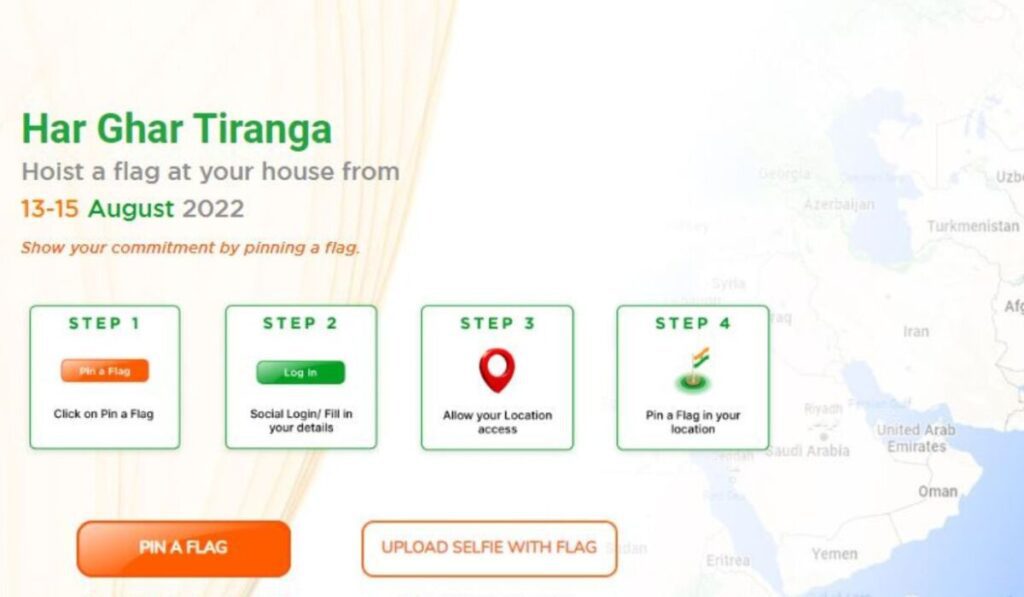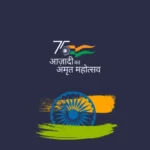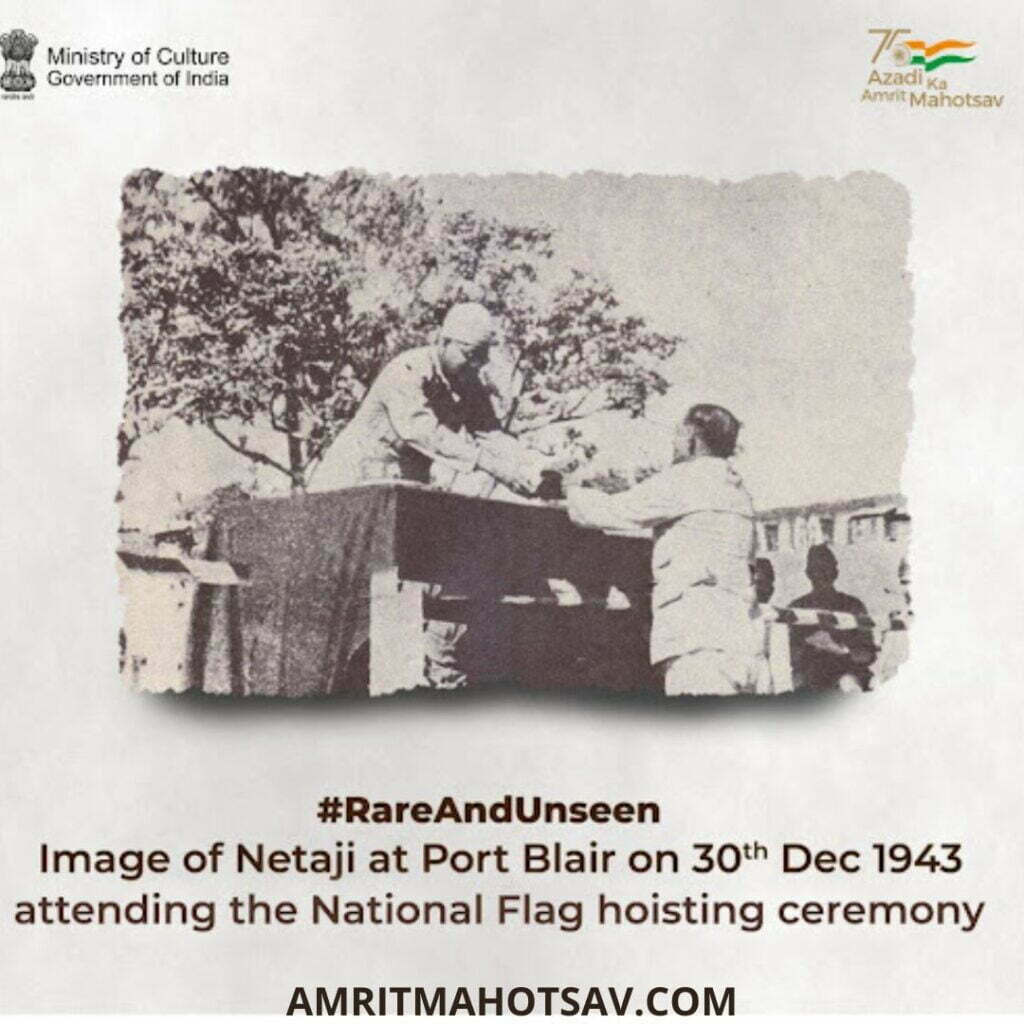Indian nationals are encouraged to hoist the national flag on the grand campaign ‘Har Ghar Tiranga’ at their homes for one week on this 75th Independence Day to honor the national flag. The flag should be made up of khadi, cotton or silk and the use of plastics is discouraged. Raw material of Khadi should be cotton, silk or wool. This will help in invoking the feeling of national pride in Indians. All the sacrifices made by the freedom fighters will be remembered and their participation will be ensured.This will help paying homage to our freedom fighters. The people who will hoist the flag from 13 August to 15 August 2023 are eligible for har ghar tiranga certificate. The Government will recognise their patriotism by issuing certificates. They also developed a portal at harghartiranga.com to provide all the information to people related to the Har Ghar Tiranga and download certificates .Get all the details related to Har ghar Tiranga.
Introduction
The National Flag of India was designed by a freedom fighter hailing from Andhra pradesh, whose name was Pingali Venkayya. A meeting of the Constituent Assembly was convened on 22 July, 1947 where it was decided to adopt the tricolor as the national flag. The national flag of India consists of stripes of three colors: saffron, white and green. The saffron is at the top, white at the center and green at the bottom. The white colored stripe contains Ashoka Chakra at the centre. Ashoka chakra is made up of a 24-spoke wheel, which is of navy blue color. The Saffron color represents Courage and sacrifice. The White color represents truth, peace, and purity. The green color represents prosperity. The Asoka Chakra represents the Laws of Dharma. The width to length ratio of the flag is 2:3 and all the strips should be equivalent in length and width. When Edmund Hillary and Sherpa Tenzing Norgay became the first persons to have reached Mount Everest, they hoisted the Indian National Flag along with flags of Nepal and the United Kingdom.
- The National Flag has 24 Dharma Chakra Spokes.
- The National Flag was designed by Pingali Venkaya.
- World War II had a global impact during the pre-independence era. The Indian National Army, led by Netaji Subhas Chandra Bose, declared the Andaman and Nicobar Islands to be part of Independent India on December 30, 1943, and renamed them ‘Shaheed-dweep’ (Martyr Island) and ‘Swaraj-dweep’ (Self-ruled Island). Netaji, as Prime Minister of the Azad Hind Government, hoisted the Indian tricolour at the Gymkhana Ground (now Netaji Stadium) in Port Blair on this occasion.
Manufacturing Process of Tiranga
Karnataka Khadi and Gramodyoga Samyukta Sangh (Federation) (KKGSSF) – is located in Bengeri village in Dharwad district. It is the only unit in India that has the license to manufacture the national flags. Bureau of Indian Standards (BIS) states has issued certain regulations in the form of three documents. BIS is authorized to cancel the licenses of units that flout guidelines. Woven material is tested by BIS laboratories. Upon successful quality testing, the remaining process of manufacturing of the flag is done. BIS is involved in each and every step of the manufacturing of the flag. Different stages of manufacturing the flag are hand spinning, hand weaving, bleaching and dyeing, printing of Ashok chakra, stitching and toggling.
Now,the government of India amends the Flag Code of India 2022 to allow for continuous display of the tricolour.
Flag Code Of India 2022
Har Ghar Tiranga’ is a campaign run by Azadi Ka Amrit Mahotsav to encourage people to bring the Tiranga home and hoist it to commemorate India’s 75th year of independence. Bringing the flag home as a nation in the 75th year of independence will become symbolic of not only an act of emotional connection with the Tiranga, but also of our commitment to nation-building. This initiative is designed to infuse patriotism in people and raise awareness of the Indian National Flag.
The Prevention of Insults to National Honour Act, 1971, and the Flag Code of India, 2022, both govern the hoisting, usage, and display of the national flag.
Some of the salient features of the Flag Code of India, 2002 are listed below for the information of the public:-
a) The Flag Code of India, 2002 was amended vide an Order dated December 30, 2021, and the National Flag made of polyester or machine made flag has been allowed. The National Flag shall be made of hand spun and hand woven or machine made, cotton/polyester/wool/silk khadi bunting.
b) A member of the public, a private organisation, or an educational institution may hoist/display the National Flag on all days and occasions, ceremonial or otherwise, consistent with the dignity and honour of the National Flag.
c) The Flag Code of India, 2002 was amended vide Order dated July 19, 2022, and clause (xi) of paragraph 2.2 of Part-II of the Flag Code of India was replaced by the following clause:- (xi) “Where the flag is displayed in open or displayed on the house of a member of the public, it may be flown day and night.”
d) The National Flag shall be rectangular in shape. The Flag can be of any size but the ratio of the length to the height (width) of the Flag shall be 3:2.
e) Whenever the national flag is displayed, it should occupy the position of honour and should be distinctly placed.
f) A damaged or dishevelled Flag shall not be displayed.
g) The flag should not be flown from a single masthead simultaneously with any other flag or flags.
h) The flag should not be flown on any vehicle except for the dignitaries mentioned in Section IX of Part III of the Flag Code, such as the President, Vice-President, Prime-Minister, Governors etc.
i) No other flag or bunting should be placed higher than or above or side by side with the National Flag.
Note:–For further details, the Prevention of Insults to National Honour Act, 1971 and the Flag Code of India, 2002 are available on the Ministry of Home Affairs’ website www.mha.gov.in.
Har Ghar Tiranga Certificate download
The National Flag of India was designed by a freedom fighter hailing from Andhra pradesh, whose name was Pingali Venkayya. A meeting of the Constituent Assembly was convened on 22 July, 1947 where it was decided to adopt the tricolor as the national flag. The national flag of India consists of stripes of three colors: saffron, white and green. The saffron is at the top, white at the center and green at the bottom. The white colored stripe contains Ashoka Chakra at the centre. Ashoka chakra is made up of a 24-spoke wheel, which is of navy blue color. The Saffron color represents Courage and sacrifice. The White color represents truth, peace, and purity. The green color represents prosperity. The Asoka Chakra represents the Laws of Dharma. The width to length ratio of the flag is 2:3 and all the strips should be equivalent in length and width. When Edmund Hillary and Sherpa Tenzing Norgay became the first persons to have reached Mount Everest, they hoisted the Indian National Flag along with flags of Nepal and the United Kingdom.
Har Ghar Tiranga Campaign
The prime objective of the Har Ghar Tiranga Campaign is to establish a personal relationship of citizens with the national flag, the Tricolour. The Government of India feels that the Indians share a very formal bond with the National Flag. It is important to feel very patriotic and emotionally attached to all that is related to the country. Thus, they launched the Har Ghar Tiranga Campaign where each Indian gets a chance to hoist the National Flag from 13 August 2022 to 15 August 2023.
This will enable them to be more aware of Tiranga and get acknowledged about the Flag Code of India, 2002. The Rashtra Gaan portal is providing all the important information pertaining to the campaign. The Government anticipates that the citizens will assuredly feel more patriotic and connected to the Tiranga post the campaign.
How to register at Har Ghar Tiranga[Registration harghartiranga.com]?

Citizens can now register themselves on the official webpage in order to hoist a flag and receive virtual recognition from the government of India for that. The har ghar tiranga portal is enabling the countrymen to pin a flag and create a virtual presence for their intention to hoist a flag from August 13 to August 15, 2022, as part of the Har Ghar Tiranga Campaign. The campaign honors India’s 75th anniversary of independence. Follow the instructions below to register online:
- Go to harghartiranga.com to access the campaign’s main website.
- Tap the Pin a Flag option on the Home page.
- Give the website access to use location services.
- The application form will now appear.
- Enter the citizen’s name and mobile number.
- The citizen’s profile photo should be uploaded.
- Click the Next button.
- The area’s exact location can be changed on the map.
- The Flag will be appreciated and marked on the map.
How to download a Har Ghar Tiranga certificate?
Citizens can now register on the official portal to hoist a flag and be recognised on a virtual level by the Government of India for doing so. The Har Ghar Tiranga Portal allows countrymen to pin a flag and establish a virtual presence for their plan to hoist a flag from 13 August 2022 to 15 August 2023 for the Har Ghar Tiranga Campaign. The campaign commemorates India’s 77th anniversary of independence. Follow the steps below to register online:
- Visit the Har Ghar Tiranga Campaign’s official website at harghartiranga.com
- Tap the Pin a Flag option on the Home page.
- Allow the website to access location services.
- The registration form will be displayed.
- Enter the citizen’s name and phone number.
- Upload the citizen’s profile picture.
- Next should be selected.
- Adjust the exact location of the area on the map.
- The Flag will be marked on the map and acknowledged

Click here for Digital Tiranga-https://harghartiranga.com/digital-tiranga
Importance of Har Ghar Tiranga certificates:
- The certificate of Har Ghar Tiranga Abhiyan will only display the name of the citizen who has received it.
- Place the flag on the right place on the virtual map of India to be honored. The campaign will also have the campaign logo.
- The certificate will be issued by the Ministry of Culture. The document will be available as a PNG image.
- Citizens can save or print it, or even directly share it online.




